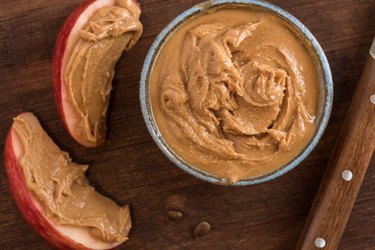
Crunchy or smooth, in a sandwich or mixed into oatmeal — however you like to eat peanut butter, go ahead and do it: It won't derail your weight-loss efforts.
In fact, adding peanut butter to your diet may help you keep weight gain at bay, according to an October 2018 study in the European Journal of Nutrition. Researchers looked at nearly 375,000 people and found that adults who regularly ate peanuts (or other nuts) gained less weight over a five-year period compared to their non-nut-eating counterparts — and some of the nut-eaters even lost weight.
Video of the Day
Video of the Day
It's similar for children. Kids who eat peanuts and peanut butter weigh less and have more nutritious diets, per a July 2013 study in Nutrition Research.
Peanut-eaters tend to get more fiber in their diets, says a 2010 study in the Asia Pacific Journal of Clinical Nutrition — and fiber can help with weight loss. Peanuts are also full of healthy fat and protein, two other nutrients that will fill you up and should keep you feeling full into your next meal (bye-bye, cravings).
Here's the catch, though: This food can quickly fall out of favor and your scale may start to tick up instead of down. If weight loss is your goal, be mindful of these four peanut butter mistakes.
Mistake 1: You’re Buying Peanut Butter With Added Salt
Most of the sodium we eat comes from processed, prepackaged and restaurant foods, per the American Heart Association. Although it's hardly processed, peanut butter falls into the prepackaged food category.
Check the ingredient list on peanut butter jars — some are made without any added salt, while others may have up to a couple hundred milligrams per serving, according to MyFoodData.
Because sodium doesn't add calories, it doesn't naturally seem like a nutrient to be worried about when you're trying to lose weight. But when you eat too much sodium, your body holds on to extra water, and that can cause puffiness, bloating, and — yes — weight gain.
Your best choice is a peanut butter — chunky or smooth — that's made with just peanuts.
Mistake 2: You’re Choosing Reduced-Fat Peanut Butter
"Reduced-fat" may sound like the healthier choice if you think fat is bad for weight loss, but this isn't the case here. Peanut butter alone can't burn body fat, but peanuts are chock-full of healthy unsaturated fats, which are filling, heart-healthy and anti-inflammatory.
Another problem with reduced-fat peanut butter is it might give you license to eat more knowing that it's "reduced fat." (Research has shown that when you think you're eating something sensible, your levels of the feel-full hormone ghrelin don't jump up as high as they do when you eat something you deem indulgent, per a July 2011 study in Healthy Psychology.)
Plus, when you compare a serving of reduced-fat peanut butter to regular peanut butter, there's not a big difference calorie-wise. Reduced-fat PB has just four fewer calories in 2 tablespoons, per MyFoodData.
Mistake 3: You’re Eating It Straight Out of the Jar
We've all been there, and trust us when we say we'll do it again. But let's not make it a habit because there is such a thing as eating too much peanut butter.
A 2-tablespoon serving of regular peanut butter — which is spot-on for a sandwich, or ample when spread across slices of apple or dropped into a smoothie — delivers 191 calories, according to MyFoodData.
But straight out of the jar, two tablespoons could be a single heaping spoonful depending on your spoon size. Dip your spoon into the jar three times and you've actually gotten a meal's worth of calories versus your intended easy and light snack.
Mistake 4: You’re Always Eating Peanut Butter With Jelly or Chocolate
Don't ditch the classic PB&J altogether, or completely forgo the divine pairing of chocolate and peanut butter. But do branch out.
Here's why: Both jelly and chocolate contribute added sugar (though sometimes you can find a jelly made without sugar). And sometimes peanut butter is made with added sugar, too. Eat too much added sugar and it can lead to unwanted weight gain and raise your obesity risk, according to the American Heart Association.
Instead, try one of these healthy ways to eat peanut butter from Sara Haas, RDN, co-author of the Fertility Foods Cookbook:
- Mix peanut butter with soy sauce, lime juice and fresh ginger to create a tasty salad dressing
- Whisk peanut butter with yogurt for a dipping sauce for fruit
- Add to granola and roll out snack bites in your hand
- Smear on toast and top with crushed red pepper and crushed peanuts
- Add a swipe on top of your favorite brand of granola bar
Ready to Lose Weight?
Set yourself up for success with LIVESTRONG.com's Weight-Loss Kickstart program.
- Eur J Nutr: "Nut intake and 5-year changes in body weight and obesity risk in adults: results from the EPIC-PANACEA study"
- Nutrition Research: " Peanut consumption in adolescents is associated with improved weight status"
- Asia Pac J Clin Nutr: "Tree nut consumption improves nutrient intake and diet quality in US adults: an analysis of National Health and Nutrition Examination Survey (NHANES) 1999-2004"
- Health Psychol: "Mind over milkshakes: mindsets, not just nutrients, determine ghrelin response"
- AHA: "Sodium Sources"
- MyFoodData: "Peanut Butter Smooth Reduced Fat"
- MyFoodData: "Unsalted Peanut Butter (Smooth)"
- AHA: "How Too Much Added Sugar Affects Your Health Infographic"